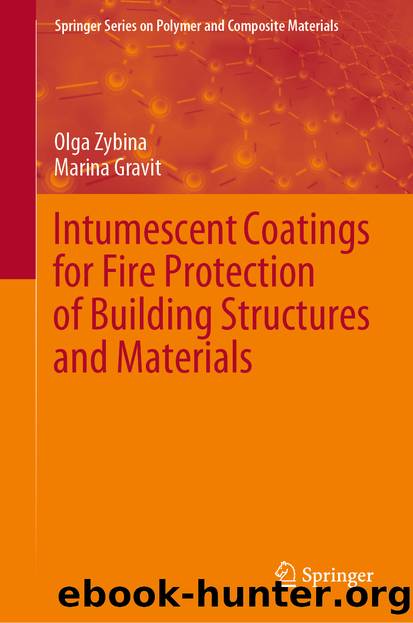Intumescent Coatings for Fire Protection of Building Structures and Materials by Olga Zybina & Marina Gravit

Author:Olga Zybina & Marina Gravit
Language: eng
Format: epub
ISBN: 9783030594220
Publisher: Springer International Publishing
The samples were tested in the mode of âstandard fireâ, in which the average furnace temperature, measured by installed thermocouples, was monitored and adjusted according to dependence [23]:
where To is the initial furnace temperature; t is the time, min.
Figure 3.5 shows the results of the calibration start-up of the furnace.
Fig. 3.5Temperature change during calibration start-up of the laboratory setup for thermophysical testing of flame-retardant coatings
Steel plates 200âÃâ200âÃâ4 mm in size covered in flame retardant were used as samples. Fire-retardant compositions were applied to cleaned, degreased, primed surface. The aimed thickness of the dry layer was 1 mm, not including the primer layer (0.3 mm). Control measurements of the actual thicknesses of the coating were made before the tests at least at nine points. The arithmetic mean value of all measurements was taken as a result. The temperature on the surface of the test plates was measured using thermoelectric converters (TECs), which were installed on the unheated surface of the samples at a rate of three pieces using a coupling method. The unheated surface of the test sample was isolated with 100 mm thick mineral wool board ROCKWOOL. The temperature of the metal of the test sample was determined as the arithmetic mean of the readings of the TECs located in the designated places. The tests were carried out until the limit state of the test sample was achieved. The limit state is the time within which a temperature of 500 °C was achieved by the steel of the test samples (average temperature by three TECs).
Even though we did not establish any direct correlation between the standardized field tests and our own ones, in our opinion, comparative laboratory methods for determining the given indicators of the flame-retardant coating can definitely characterize the change in the flame-retardant qualities of the intumescent material. However, it is obvious that a compact electric-heated laboratory setup lacks, for example, some important factors typical for fire, such as the impact force of turbulent flows of hot gases. Therefore, the time when the samples achieve the limiting state during field tests is shorter.
Compositions that were identical in terms of their content and based on ammonium polyphosphate, melamine, and pentaerythritol were tested. Only the type of film former varied. The binder content was 22% (mass.) with respect to the remaining mass of the ingredients. The results of our research in the flame-retardant characteristics of the fire protection char-forming compositions based on various types of water-dispersion binders are presented in Table 3.4.Table 3.4Flame-retardant indicators of intumescent compositions based on various water dispersions of binder polymers
Download
This site does not store any files on its server. We only index and link to content provided by other sites. Please contact the content providers to delete copyright contents if any and email us, we'll remove relevant links or contents immediately.
| Concrete | Extraction & Processing |
| Fracture Mechanics | Materials Science |
| Metallurgy | Polymers & Textiles |
| Strength of Materials | Testing |
Whiskies Galore by Ian Buxton(40297)
Introduction to Aircraft Design (Cambridge Aerospace Series) by John P. Fielding(32331)
Small Unmanned Fixed-wing Aircraft Design by Andrew J. Keane Andras Sobester James P. Scanlan & András Sóbester & James P. Scanlan(32135)
Craft Beer for the Homebrewer by Michael Agnew(17439)
Turbulence by E. J. Noyes(7032)
The Complete Stick Figure Physics Tutorials by Allen Sarah(6631)
Kaplan MCAT General Chemistry Review by Kaplan(6044)
The Thirst by Nesbo Jo(5778)
Bad Blood by John Carreyrou(5761)
Learning SQL by Alan Beaulieu(5399)
Weapons of Math Destruction by Cathy O'Neil(5029)
Man-made Catastrophes and Risk Information Concealment by Dmitry Chernov & Didier Sornette(4728)
iGen by Jean M. Twenge(4693)
Digital Minimalism by Cal Newport;(4511)
Life 3.0: Being Human in the Age of Artificial Intelligence by Tegmark Max(4492)
Audition by Ryu Murakami(4091)
1,001 ASVAB Practice Questions For Dummies by Powers Rod(4034)
Electronic Devices & Circuits by Jacob Millman & Christos C. Halkias(4021)
Pale Blue Dot by Carl Sagan(3996)
